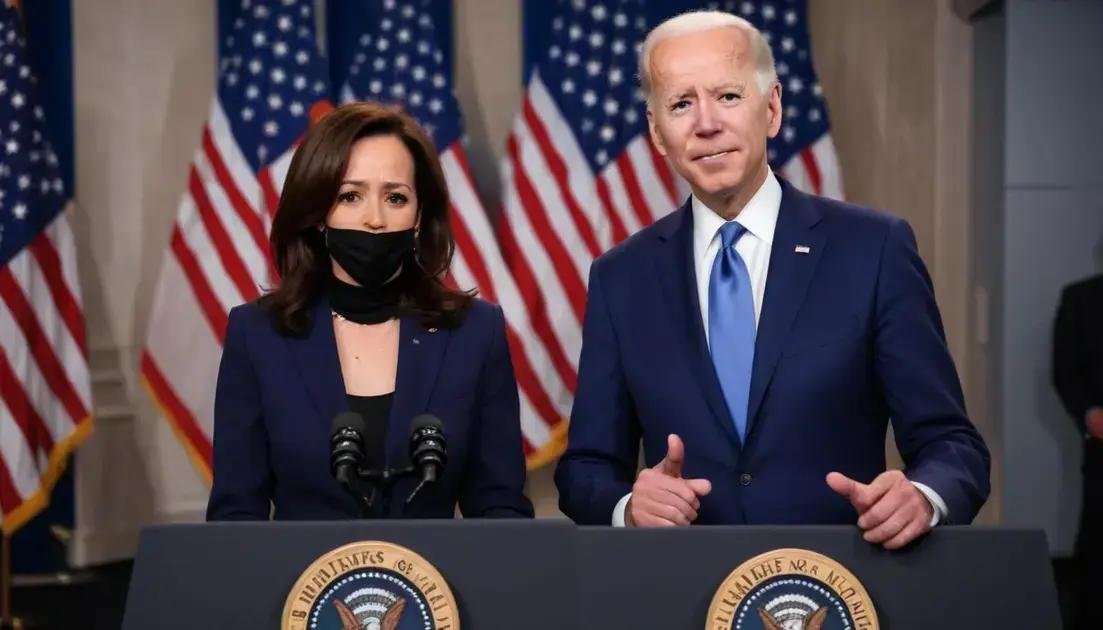The Biden-Harris administration faces challenges including economic recovery, climate change initiatives, and social justice issues, requiring effective public engagement and collaboration to achieve its goals.
The Biden-Harris transition marks a significant shift in American politics. What does this mean for the country moving forward? Join us as we delve into the implications and explore the anticipated changes.
Understanding the Biden-Harris transition
Understanding the Biden-Harris transition is vital for grasping the changes in American governance. It sets the stage for new policies that can impact various sectors across the country. This transition marks a pivotal moment in the political landscape.
Key Aspects of the Transition
During this transition, several key aspects influence how the Biden-Harris administration will operate. They emphasize inclusivity and aim to address pressing issues that matter to the American public.
- Appointment of diverse leaders in key positions
- Focus on restoring relationships with international allies
- Emphasis on climate change and sustainability practices
- Renewed attention to social justice and equity
The administration’s approach to governance is shaped by initiatives that aim to unify the country. Collaboration with various stakeholders is essential. For example, the Biden-Harris team seeks input from communities previously sidelined in the political process.
Challenges Ahead
As the Biden-Harris administration takes shape, it faces numerous challenges. Addressing the ongoing pandemic remains at the forefront. Furthermore, economic recovery and systemic inequalities need urgent attention. The government must find effective strategies to manage these complex issues while maintaining public trust.
The transition also involves a cultural shift within the government. There is a renewed push for transparency and accountability. Citizens are calling for more engagement and participation in government decisions. As the Biden-Harris transition progresses, it will be crucial to observe how these changes unfold.
Key appointments in the Biden-Harris administration
Key appointments in the Biden-Harris administration are shaping the direction of the government. These positions play a vital role in implementing policy changes across various sectors. Understanding who fills these roles can help the public grasp how these decisions impact their lives.
Significant Positions and Their Importance
Among the most notable appointments are those of cabinet members and advisors. Each individual brings their own experiences and priorities, influencing the administration’s goals.
- The Secretary of State: Focuses on foreign relations and international diplomacy.
- The Secretary of the Treasury: Deals with economic policies and financial regulations.
- The Secretary of Health and Human Services: Addresses healthcare and public health issues.
- The Secretary of the Interior: Manages public lands and natural resources.
These appointments reflect a diverse range of perspectives. The Biden-Harris administration aims for inclusion and representation in leadership positions. Not only does this strengthen the government, but it also demonstrates a commitment to addressing issues that matter to different communities.
Impacts on Policy Implementation
Each appointee impacts how policies are formulated and executed. For example, the Secretary of State may prioritize rebuilding alliances with other countries, while the Secretary of the Treasury could focus on economic recovery plans. This interconnectedness means that the effectiveness of these appointments can significantly affect the administration’s success.
The selection of these key figures also signals the administration’s values. By prioritizing experienced and diverse leaders, the Biden-Harris administration sets a tone for collaboration and unity in addressing national challenges. As these leaders take their positions, it will be essential to watch their strategies and initiatives unfold.
Policy changes on climate action
Policy changes on climate action are a central focus of the Biden-Harris administration. These changes aim to address urgent environmental issues and promote sustainability. Understanding these policies helps citizens grasp how their government is tackling climate change.
Renewable Energy Initiatives
One major area of focus is investing in renewable energy sources. The administration plans to promote solar, wind, and other clean energy options. These initiatives strive to reduce reliance on fossil fuels, fostering a healthier environment.
- Tax incentives for solar panel installation
- Funding for wind energy projects
- Investment in electric vehicle infrastructure
- Support for research in energy-efficient technologies
By prioritizing renewable energy, the Biden-Harris administration not only aims to combat climate change but also seeks to create jobs in the green energy sector. This approach shows a commitment to both the economy and the environment.
International Agreements
The Biden-Harris administration rejoined international commitments like the Paris Agreement, signaling a strong stance on global climate action. Participating in these agreements helps the U.S. collaborate with other nations on environmental issues. Strengthening alliances is key to tackling climate change effectively.
Moreover, by engaging in these discussions, the administration promotes accountability for climate goals. This includes setting ambitious targets for reducing greenhouse gas emissions. As international negotiations unfold, the impact of the U.S. re-engagement will be closely monitored.
Additionally, the administration is addressing climate equity. This means ensuring that policies benefit vulnerable communities disproportionately affected by climate change. By focusing on these issues, the Biden-Harris team is looking to create a more just and sustainable future for all.
Economic implications of the transition

The economic implications of the Biden-Harris transition are significant as they set the stage for new policies that can reshape various sectors. With a focus on recovery and growth, the administration aims to create a stable economic environment for all Americans.
Job Creation and Green Economy
One of the primary goals is to create jobs, especially in the green economy. The administration plans to invest in clean energy, which can lead to thousands of new employment opportunities. Initiatives supporting job training programs aim to prepare workers for these emerging sectors.
- Investments in renewable energy sources like wind and solar
- Development of electric vehicle infrastructure
- Funding for energy efficiency projects in buildings
- Promotion of sustainable agriculture practices
These measures not only enhance economic growth but also work toward a sustainable future, aligning economic benefits with environmental responsibility.
Impact on Small Businesses
The Biden-Harris administration also plans to support small businesses, which are vital for local economies. Through various programs, the government aims to provide financial assistance and resources for small enterprises recovering from the pandemic.
By focusing on equitable access to funding and resources, small businesses can thrive. This includes expanding access to loans and grants, especially for minority-owned businesses. Empowering small business owners contributes to economic diversity and resilience.
The transition also introduces potential tax reforms that may affect individuals and corporations. Changes in tax policies may encourage spending and investment in key sectors. Understanding these economic implications is essential for predicting future trends and adjustments in the market.
Healthcare reform initiatives
Healthcare reform initiatives are a key focus of the Biden-Harris administration. They aim to improve access and affordability for all Americans. By addressing systemic issues in the healthcare system, the administration hopes to create a healthier society.
Expanding Access to Healthcare
One important initiative is expanding access to healthcare. This includes increasing enrollment options for Medicaid and the Affordable Care Act (ACA). The goal is to reduce the number of uninsured individuals and families.
- Enhancing subsidies for health insurance premiums
- Streamlining the enrollment process
- Extending enrollment periods for the ACA
- Providing funding for community health centers
These measures make healthcare more accessible, ensuring that more people receive the medical attention they need. By making healthcare services available, the administration seeks to reduce health disparities among different populations.
Focus on Mental Health
Another significant area of focus is mental health services. The administration recognizes the increasing importance of mental health and aims to integrate these services into primary care. This holistic approach fosters a more comprehensive healthcare system.
Initiatives include increasing funding for mental health programs and expanding access to telehealth services. This ensures that individuals can receive support, regardless of their location. By promoting mental health, the administration promotes overall well-being.
Additionally, the Biden-Harris administration is prioritizing health equity. This means addressing the unique challenges faced by underserved communities. By focusing on social determinants of health, such as housing and income, the administration aims to ensure that everyone has a fair opportunity to achieve good health.
Foreign policy shifts under Biden
Foreign policy shifts under Biden represent a dramatic change in the United States’ approach to international relations. This administration aims to rebuild alliances and restore America’s role on the world stage. Understanding these shifts is key to grasping future developments in global affairs.
Reestablishing International Alliances
One of the significant aspects of Biden’s foreign policy is the effort to reestablish international alliances. The administration believes in multilateralism, meaning working with other countries to address global issues. By collaborating with allies, the U.S. strengthens its position in the international community.
- Rejoining the Paris Agreement on climate change
- Engaging with NATO partners for common security goals
- Participating in the World Health Organization (WHO) to tackle global health crises
- Strengthening ties with traditional allies in Europe and Asia
This focus on collaboration aims to tackle shared challenges, such as climate change, security threats, and public health issues. By building partnerships, the Biden administration hopes to create a more stable and secure world.
Addressing Global Challenges
The Biden administration is also committed to addressing pressing global challenges, including the COVID-19 pandemic and climate change. The approach emphasizes the importance of working together with global partners to find solutions.
This includes increasing funding for international vaccine distribution and committing to reducing greenhouse gas emissions. By taking decisive action, the administration aims to showcase U.S. leadership in global health and environmental issues.
Additionally, the administration focuses on promoting human rights and democracy abroad. Advocating for these values is essential as the U.S. reaffirms its commitment to standing against authoritarianism. Biden’s foreign policy is about not only responding to threats but also promoting a global landscape that respects human dignity and freedom.
Public reaction to the new administration
Public reaction to the new administration of President Biden and Vice President Harris is mixed, reflecting a diverse range of opinions and expectations. Many Americans are hopeful about changes in leadership, while others express skepticism about the administration’s ability to deliver.
Positive Expectations
Supporters of the Biden-Harris administration highlight several areas where they expect progress. These include policies aimed at addressing climate change, expanding healthcare access, and fostering economic recovery post-pandemic.
- Increased funding for renewable energy initiatives
- Expansion of the Affordable Care Act
- Job creation through infrastructure projects
- Efforts to unify the country
Many citizens see these efforts as necessary steps towards a more equitable and sustainable future. The emphasis on rebuilding relationships with allies also boosts confidence in the administration’s foreign policy direction.
Concerns and Criticism
Despite the optimism, there are significant concerns among various groups. Critics point to rising inflation, immigration policies, and the pace of change as issues that need immediate attention. Some citizens feel the administration could be more aggressive in addressing economic challenges.
Additionally, polarization in American society affects public perception. Different political beliefs lead to varying reactions to the same policies. For instance, while some see initiatives as beneficial, others view them as harmful or ineffective.
Social media plays a vital role in shaping public opinion. Platforms amplify voices from all sides, influencing how people view the administration’s actions. This constant feedback can impact decision-making and policy direction moving forward.
Future challenges for the Biden-Harris team

Future challenges for the Biden-Harris team will significantly impact the success of their administration. Navigating these challenges is crucial as they aim to fulfill campaign promises and respond to the needs of the American people.
Managing Economic Recovery
One of the most pressing issues is managing economic recovery, particularly in the wake of the COVID-19 pandemic. The administration must work to stabilize the economy while addressing inflation and supply chain disruptions. This involves creating jobs and ensuring that support reaches those who need it most.
- Implementing effective stimulus measures
- Boosting support for small businesses
- Addressing workforce shortages in key sectors
- Promoting fair wages and labor protections
Finding the right balance between economic growth and inflation control will be crucial to maintaining public confidence in the administration’s ability to steer the country towards stability.
Climate Change Initiatives
Tackling climate change presents another critical challenge. The Biden-Harris administration aims to implement ambitious climate policies, but resistance from various sectors may arise. Achieving cooperation between industry leaders and environmental advocates is essential for realizing green initiatives.
This includes accelerating the transition to renewable energy and setting aggressive emission goals. Ensuring economic opportunities in the green sector while addressing climate change will be vital for long-term sustainability. The administration must also engage local communities and consider their input in policy-making.
Additionally, foreign policy challenges like international climate agreements require deft diplomacy. The administration must navigate relationships with other nations to achieve shared environmental goals while upholding U.S. interests.
Social Justice and Equity Issues
Social justice issues also remain a significant challenge. The administration has committed to addressing systemic inequalities, which requires ongoing efforts to promote equity in health care, education, and criminal justice reform. Ensuring that marginalized voices are heard in policy discussions will be essential for building trust.
There may be pushback from groups resistant to changes aimed at promoting equity, which requires careful communication and advocacy. Bridging divides within society can foster a more inclusive political landscape.
FAQ – Frequently Asked Questions about the Biden-Harris Administration
What are the main challenges facing the Biden-Harris administration?
The main challenges include managing economic recovery, addressing climate change, promoting social justice, and improving public engagement.
How does the Biden-Harris administration plan to address climate change?
The administration aims to implement ambitious policies, increase investments in renewable energy, and engage with global partners to meet climate goals.
What steps are being taken to ensure economic recovery?
Steps include implementing stimulus measures, supporting small businesses, and addressing inflation to stabilize the economy.
How does public reaction influence the administration’s policies?
Public reactions, whether positive or critical, shape policy decisions and communication strategies, impacting the administration’s overall effectiveness.






